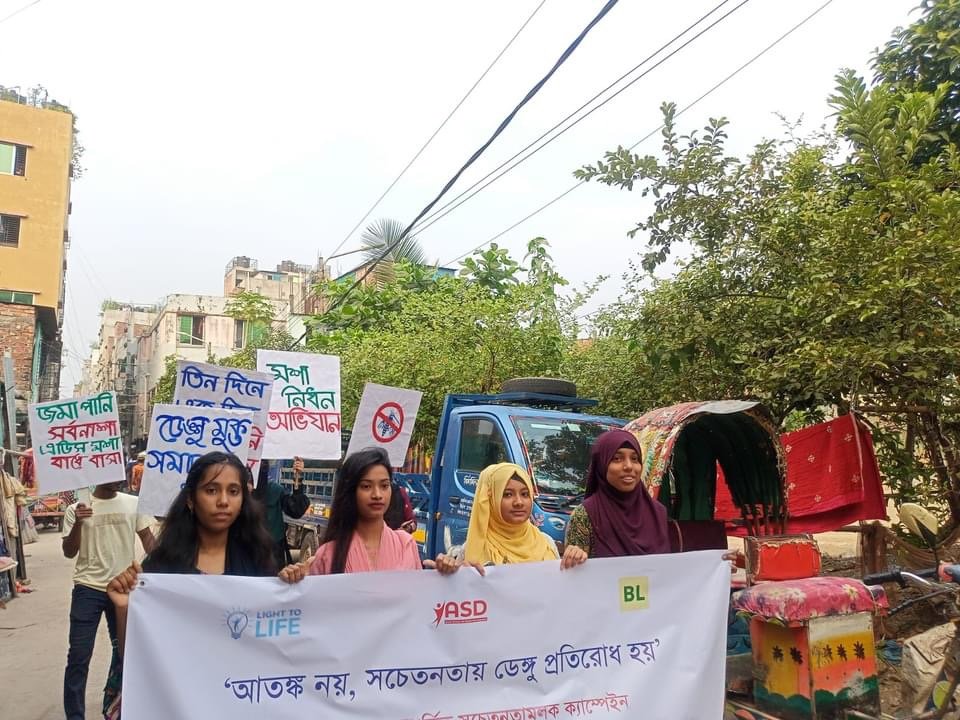Q3 - Defeat Dengue Drive - Phase 1
Impact Snapshot
Timeline: Oct. 2023 - Jan. 2024
Beneficiaries: 200 people
Locations: Dhaka | Chattogram
Partners: Light to Life | DWS
SDG Alignment: SDG 3
$467 out of $400 raised
Our Esteemed Donors
Tanya Huq, Saadia Nusrat, Hasrat Islam, Shafkatul Haque, Rubab Chowdhury, Rakin Hassan
Impact Summary
In October 2023, the Defeat Dengue Drive was launched to mitigate Bangladesh's dengue crisis. Our inaugral signature initiative, aligning with WHO guidelines, aimed to curb dengue transmission through strategic collaborations between public and private sectors, emphasizing community engagement and effective resource allocation.
Targeting vulnerable groups in slums and disabled individuals at higher dengue risk, the project partnered with Light to Life and Disabled Welfare Society (DWS). Our actions included volunteer-driven source reduction, local resident training, and distributing mosquito nets to 200 individuals, funded by a $467 BacharLorai-led crowdfunding campaign.
We collaborated with the Ministry of Health, Dhaka North, and Dhaka South City Corporations, organizing impactful distribution events in Dhaka and Chittagong. These included a noteworthy appearance by Taijul Islam from the Bangladesh National Cricket Team. Additionally, the project engaged youth leaders, fostering their role in dengue prevention advocacy. The initiative concluded with a seminar, partnering with our allies to share insights and encourage policymaker dialogue for long-term dengue control solutions.
BacharLorai is currently undertaking research to assess the initiative's impact and explore further collaborative opportunities between the government and NGOs in the fight against dengue.
Photo Gallery
SDG Alignment
The initiative primarily aligns with the following SDG 3 targets:
3.3: By 2030, end the epidemics of AIDS, tuberculosis, malaria, and neglected tropical diseases and combat hepatitis, water-borne diseases and other communicable diseases.
3.d: Strengthen the capacity of all countries, in particular developing countries, for early warning, risk reduction, and management of national and global health risks.
Context
The Defeat Dengue Drive adopted a coordinated strategic approach, emphasizing both immediate relief through mosquito net distribution and long-term sustainable solutions through community engagement and primary research dissemination. The project underscored the significance of community engagement and collaboration to create a lasting social impact in the ongoing battle against dengue in Bangladesh, benefiting 200 people directly and reaching a broader audience through policy advocacy and knowledge dissemination.
Dengue is a public health issue in Bangladesh. For the last two decades government intervention and private efforts have been underway to tackle the issue. According to the WHO, from January to August 2023, Bangladesh reported 69,483 dengue cases and 327 deaths, with a 0.47% fatality rate. The majority occurred in July. This year's surge is earlier and deadlier than previous years. Unusual rainfall, high temperatures, and humidity, along with the highest mosquito density in five years, have contributed to this rise. According to local and global news outlets, over the past two months we have witnessed an exponential increase in the number of cases, with DGHS press releases showing total numbers for 2023 exceeding 1100 deaths.
Evidence suggests that although the capital Dhaka city is hyperendemic to the viral disease, coordinated measures are yet to be successfully implemented. This is due to a lack of infrastructure, human resources and community engagement. Dengue mosquitoes thrive in areas close to the human population and lay their eggs in water-filled containers inside the house and surrounding areas of dwellings. Adult mosquitoes rest indoors in dark areas where they are protected from wind, rain and most predators.
WHO recommends three effective strategies to fight dengue:
Source Reduction: Eliminating the mosquitoes’ egg laying sites, called source reduction, as the best preventative measure. This can be done by covering or properly discarding items that collect rainwater or are used to store water. It can also emptying, scrubbing and cleaning to remove mosquito eggs at least once a week.
Examples of indoor sites: Ant traps, Flower vases and saucers, Water storage tanks, Plastic containers and bottles.
Examples of outdoor sites: Discarded bottles and tins, Discarded tyres, Artificial containers, Tree holes, potholes, construction sites, Drums for collecting rainwater, Shells, husks, pods from trees, Leaf axils of various plants, Boats and abandoned equipments.
Community Engagement: Citizens’ participation is the key to dengue prevention. As every household aims to reduce dengue mosquito reproduction, the transmission rate will decrease or maybe even stop.
Mosquito Bite Prevention: Minimize mosquito bites through the provision of clothes that cover as much of your body as possible; mosquito nets if sleeping during the day, ideally nets sprayed with insect repellent; window screens; mosquito repellents (containing DEET, Picaridin or IR3535) along with coils and vaporizers.












